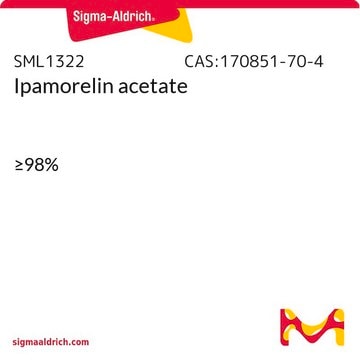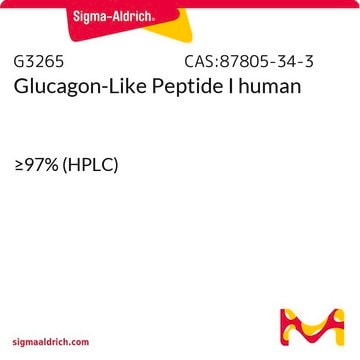S7147
Secretin human
≥97% (HPLC), powder
About This Item
Productos recomendados
Análisis
≥97% (HPLC)
formulario
powder
temp. de almacenamiento
−20°C
cadena SMILES
CC(C)C[C@H](NC(=O)CNC(=O)[C@H](CCC(N)=O)NC(=O)[C@H](CC(C)C)NC(=O)[C@H](CC(C)C)NC(=O)[C@H](CCCNC(N)=N)NC(=O)[C@H](CCC(N)=O)NC(=O)[C@H](CC(C)C)NC(=O)[C@H](CCCNC(N)=N)NC(=O)[C@H](C)NC(=O)CNC(=O)[C@H](CCC(O)=O)NC(=O)[C@H](CCCNC(N)=N)NC(=O)[C@H](CC(C)C)NC(=O)[C@H](CCCNC(N)=N)NC(=O)[C@H](CO)NC(=O)[C@H](CC(C)C)NC(=O)[C@H](CCC(O)=O)NC(=O)[C@H](CO)NC(=O)[C@@H](NC(=O)[C@H](Cc1ccccc1)NC(=O)[C@@H](NC(=O)CNC(=O)[C@H](CC(O)=O)NC(=O)[C@H](CO)NC(=O)[C@@H](N)Cc2c[nH]cn2)[C@@H](C)O)[C@@H](C)O)C(=O)N[C@@H](C(C)C)C(N)=O
InChI
1S/C130H220N44O40/c1-60(2)43-81(120(208)173-100(66(13)14)103(134)191)153-95(183)54-149-106(194)77(31-35-92(132)180)159-116(204)84(46-63(7)8)166-118(206)85(47-64(9)10)164-111(199)75(29-23-41-146-129(139)140)155-113(201)79(32-36-93(133)181)160-117(205)83(45-62(5)6)162-110(198)73(27-21-39-144-127(135)136)154-104(192)67(15)152-94(182)53-148-107(195)78(33-37-97(185)186)158-109(197)74(28-22-40-145-128(137)138)156-115(203)82(44-61(3)4)163-112(200)76(30-24-42-147-130(141)142)157-122(210)90(57-176)170-119(207)86(48-65(11)12)165-114(202)80(34-38-98(187)188)161-123(211)91(58-177)171-126(214)102(69(17)179)174-121(209)87(49-70-25-19-18-20-26-70)168-125(213)101(68(16)178)172-96(184)55-150-108(196)88(51-99(189)190)167-124(212)89(56-175)169-105(193)72(131)50-71-52-143-59-151-71/h18-20,25-26,52,59-69,72-91,100-102,175-179H,21-24,27-51,53-58,131H2,1-17H3,(H2,132,180)(H2,133,181)(H2,134,191)(H,143,151)(H,148,195)(H,149,194)(H,150,196)(H,152,182)(H,153,183)(H,154,192)(H,155,201)(H,156,203)(H,157,210)(H,158,197)(H,159,204)(H,160,205)(H,161,211)(H,162,198)(H,163,200)(H,164,199)(H,165,202)(H,166,206)(H,167,212)(H,168,213)(H,169,193)(H,170,207)(H,171,214)(H,172,184)(H,173,208)(H,174,209)(H,185,186)(H,187,188)(H,189,190)(H4,135,136,144)(H4,137,138,145)(H4,139,140,146)(H4,141,142,147)/t67-,68+,69+,72-,73-,74-,75-,76-,77-,78-,79-,80-,81-,82-,83-,84-,85-,86-,87-,88-,89-,90-,91-,100-,101-,102-/m0/s1
Clave InChI
OWMZNFCDEHGFEP-NFBCVYDUSA-N
Información sobre el gen
human ... SCT(6343) , SCTR(6344)
Amino Acid Sequence
Descripción general
Aplicación
- in the radioimmunoassay with oxyntomodulin
- to test its effect on the enlargement and swelling of human endoderm stem cells (hEnSCs) derived cyst
- to stimulate human induced pluripotent stem cells (iPSC)-derived biliary cells in cyclic adenosine monophosphate (cAMP) assays to test its effect on cAMP production
Acciones bioquímicas o fisiológicas
Código de clase de almacenamiento
11 - Combustible Solids
Clase de riesgo para el agua (WGK)
WGK 3
Punto de inflamabilidad (°F)
Not applicable
Punto de inflamabilidad (°C)
Not applicable
Equipo de protección personal
Eyeshields, Gloves, type N95 (US)
Certificados de análisis (COA)
Busque Certificados de análisis (COA) introduciendo el número de lote del producto. Los números de lote se encuentran en la etiqueta del producto después de las palabras «Lot» o «Batch»
¿Ya tiene este producto?
Encuentre la documentación para los productos que ha comprado recientemente en la Biblioteca de documentos.
Nuestro equipo de científicos tiene experiencia en todas las áreas de investigación: Ciencias de la vida, Ciencia de los materiales, Síntesis química, Cromatografía, Analítica y muchas otras.
Póngase en contacto con el Servicio técnico








